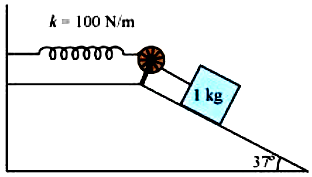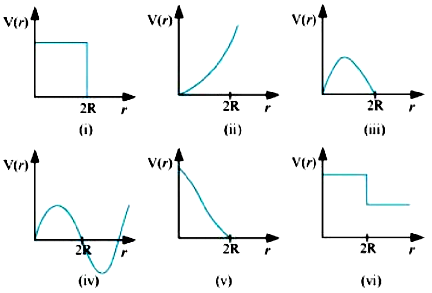A person trying to lose weight (dieter) lifts a \(10~\text{kg}\) mass, one thousand times, to a height of \(0.5~\text m\) each time. Assume that the potential energy lost each time she lowers the mass is dissipated. How much work does she do against the gravitational force?
1. \(29,000~\text J\)
2. \(49,000~\text J\)
3. \(21,000~\text J\)
4. \(18,000~\text J\)
1. \(29,000~\text J\)
2. \(49,000~\text J\)
3. \(21,000~\text J\)
4. \(18,000~\text J\)
1. \(180~\text{m}^2\)
2. \(150~\text{m}^2\)
3. \(200~\text{m}^2\)
4. \(300~\text{m}^2\)
A 1 kg block situated on a rough incline is connected to a spring of spring constant as shown in the figure. The block is released from rest with the spring in the unstretched position. The block moves 10 cm down the incline before coming to rest. The coefficient of friction between the block and the incline is:
(Assume that the spring has a negligible mass and the pulley is frictionless.)

1. 0.03
2. 0.14
3. 0.11
4. 0.08
A bolt of mass 0.3 kg falls from the ceiling of an elevator moving down at a uniform speed of 7 m/s. It hits the floor of the elevator (length of the elevator = 3 m) and does not rebound. What is the heat produced by the impact?
1. 8.82 J
2. 7.65 J
3. 7.01 J
4. 7.98 J
Which of the following potential energy curves can possibly describe the elastic collision of two billiard balls? Here r is the distance between the centres of the balls.

1. (i) and (iii)
2. (ii), (iii), and (iv)
3. (v) and (vi)
4. only (v)
A string is used to pull a block of mass m vertically up by a distance h at a constant acceleration . The work done by the tension in the string is
1.
2.
3.
4.
A body constrained to move in the z-direction is subjected to a force given by . What is the work done by the force in moving the body through a distance of 5m along the z-axis?
1. 15 J
2. -15 J
3. -50 J
4. 25 J
If 250 J of work is done in sliding a 5 kg block up an inclined plane of height 4 m. Work done against friction is: (g=10 ms-2)
1. 50 J
2. 100 J
3. 200 J
4. Zero
A man carries a load on his head through a distance of 5 m. The maximum amount of work is done when he:
1. moves it over an inclined plane.
2. moves it over a horizontal surface.
3. lifts it vertically upwards.
4. None of these
A body moves a distance of 10 m along a straight line under the action of a force 5 N. If the work done is 25 joule, the angle which the force makes with the direction of motion of body is
1.
2.
3.
4.






